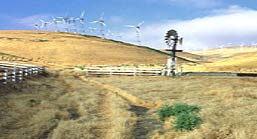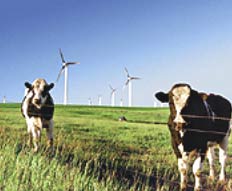|
Introduction to wind energy for farmers and researchers
By Syed Iqbal Haider
The following article will help you learn how a small wind
energy system could provide your farm or ranch with
electricity.
Wind's energy have been harnessing for hundreds of years. From
old Holland to farms in the United States, windmills have been
used for pumping water or grinding grain. Today, the
windmill's modern equivalent— a wind turbine— can use the
wind's energy to generate electricity.
 Wind
turbines, like windmills, are mounted on a tower to capture
the most energy. At 100 feet (30 meters) or more aboveground,
they can take advantage of the faster and less turbulent wind.
Turbines catch the wind's energy with their propeller-like
blades. Usually, two or three blades are mounted on a shaft to
form a rotor. Wind
turbines, like windmills, are mounted on a tower to capture
the most energy. At 100 feet (30 meters) or more aboveground,
they can take advantage of the faster and less turbulent wind.
Turbines catch the wind's energy with their propeller-like
blades. Usually, two or three blades are mounted on a shaft to
form a rotor.
A blade acts much like an airplane wing. When the wind blows,
a pocket of low-pressure air forms on the downwind side of the
blade. The low-pressure air pocket then pulls the blade
towards it, causing the rotor to turn.
This is called lift. The force of the lift is actually much
stronger than the wind's force against the front side of the
blade, which is called drag. The combination of lift and drag
causes the rotor to spin like a propeller, and the turning
shaft spins a generator to make electricity.
Wind Turbines, with peak production capacity from 100watt to 5
killowatt (5000watt) per hour, are generally known as Small
Wind Turbines and are for use in small homes and farms.
Wind Turbines are now available in all sizes where a single
unit is capable of producing power up to 3,000,000watt (3
Million Watts or MegaWatt or MW). The larger machines are
highly sophisticated and fully computerized, whereas the
smaller units come in all sorts of variations and could be
very simple and easy to build yourself.
Wind turbines can be used as stand-alone applications, or they
can be connected to a utility power grid or even combined with
a photovoltaic (solar cell) system, called Hybrid System.
 |
| Cows share a field with
large wind turbines: |
For utility-scale sources of wind energy, a
large number of wind turbines are usually built close together
to form a wind plant, as shown behind the cows in this
picture.
Electricity providers, such as WAPDA, are using wind plants
(also called Wind Farms) to supply power to their customers.
Small wind turbines are typically used for water pumping or
communications. Field camps, homeowners, farmers, and ranchers
in windy areas. Wind turbines are a good way to cut pollution
by replacing diesel an petrol generators as well as to reduce
your electric bills.
Small wind systems also have potential as distributed energy
resources. Distributed energy resources refer to a variety of
small, modular power-generating technologies that can be
combined to improve the operation of the electricity delivery
system.
The Writer is a permanent Contributor to Pakissan.com..
----------------------------------------------------------
Syed
Iqbal Haider
CEO - Enviro
Impact Consultants (EIC), Canada
M.Sc., PG.D. (Wales), MEIC (Canada), MCGS (Canada)
syedhaider@cosmo.com
|
Pakissan.com;
|